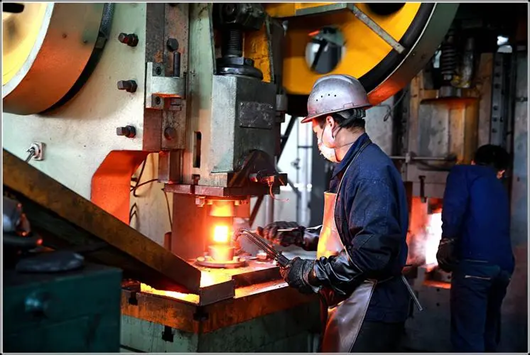Forging is an important metal processing method that produces plastic deformation of metal billets by applying pressure, thereby obtaining forgings of the desired shape and size. According to the different tools used, production processes, temperatures, and forming mechanisms, forging methods can be divided into multiple types, each with its specific application scope.
l Classification of forging methods
1.Open forging classified by tools and processes used:
u Open forging: Using simple tools such as hammers, anvils, and type anvils, or directly applying external force between the upper and lower anvils of forging equipment to deform the billet and obtain the desired forging. Free forging has a large machining allowance, low production efficiency, and the mechanical properties and surface quality of forgings are greatly affected by production operators. It is suitable for the production of single pieces, small batches, or large forgings.
u Die forging: Place the billet into a mold with a specific shape, and apply pressure through equipment such as forging hammers, pressure sliders, or hydraulic presses to deform the billet into the desired shape inside the mold. The forging allowance is small, the production efficiency is high, the internal structure is uniform, and it is suitable for producing large batches and complex shaped forgings. Forging can be further divided into open forging and closed forging, as well as hot forging, warm forging, and cold forging.
u Special forging: using specialized equipment or special processes for forging, such as roll forging, cross wedge rolling, radial forging, liquid forging, etc. These forging methods are suitable for producing parts with certain special shapes or performance requirements, which can greatly improve production efficiency and forging quality.
2. Hot forging classified by temperature:
u Hot forging: Forging is carried out above the recrystallization temperature of the metal, usually at a heating temperature of 900 ° C or above, to give the metal good plasticity and low deformation resistance, easy forming, and good microstructure and properties after forging.
u Warm forging: Forging is carried out within a temperature range below the recrystallization temperature but above room temperature, which is between hot forging and cold forging. It has some advantages of hot forging and cold forging, such as better plasticity and lower deformation resistance, while avoiding oxidation and decarburization problems during hot forging.
u Cold forging: Forging is carried out at room temperature or below, mainly used for producing high-precision, high surface quality parts, but with high deformation resistance and high requirements for equipment and molds.
l Application scope
The forging method is widely used in various fields such as mechanical manufacturing, aerospace, automobiles, ships, weapons, petrochemicals, etc. There are various types of forged parts, including shaft components, rod components, gears, splines, collars, sprockets, ring gears, flanges, connecting pins, liners, rocker arms, fork heads, ductile iron tubes, valve seats, gaskets, piston pins, crank sliders, etc. Forged parts have the characteristics of high load-bearing capacity, long service life, and strong adaptability to harsh working conditions, which can meet the requirements of various complex working conditions.
With the continuous progress of technology and innovation of processes, the emergence of new forging methods such as precision forging technology, isothermal forging technology, and liquid forging technology has further expanded the application scope of forging technology and improved the quality level of forgings.
Forging methods can be classified into various types based on the tools used, production processes, temperatures, and forming mechanisms, each with its specific application scope. In practical applications, the appropriate forging method should be selected based on factors such as the shape, size, performance requirements, and production batch of the parts
Post time: Oct-29-2024





